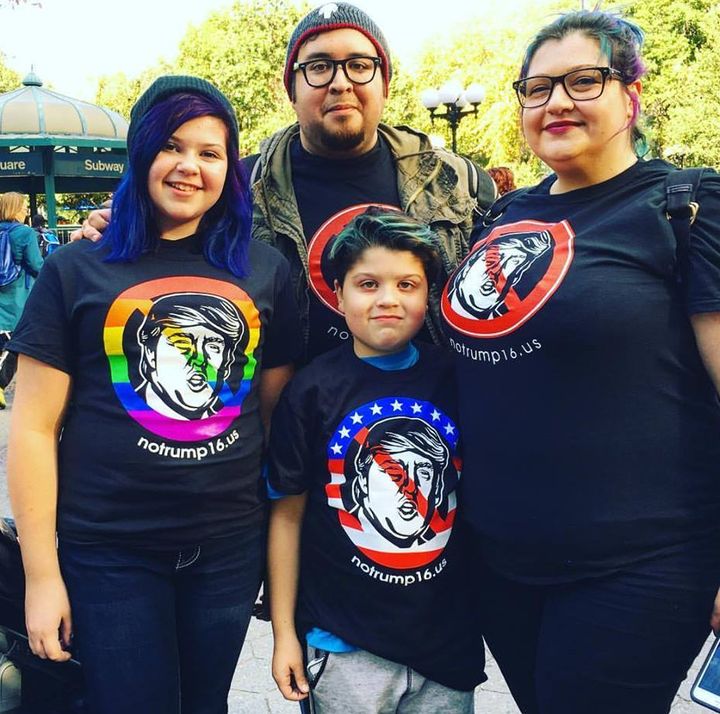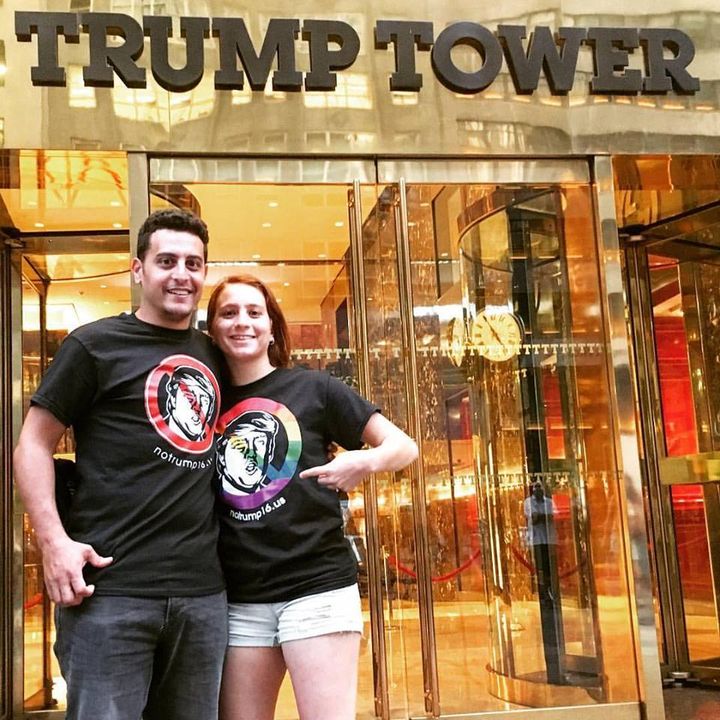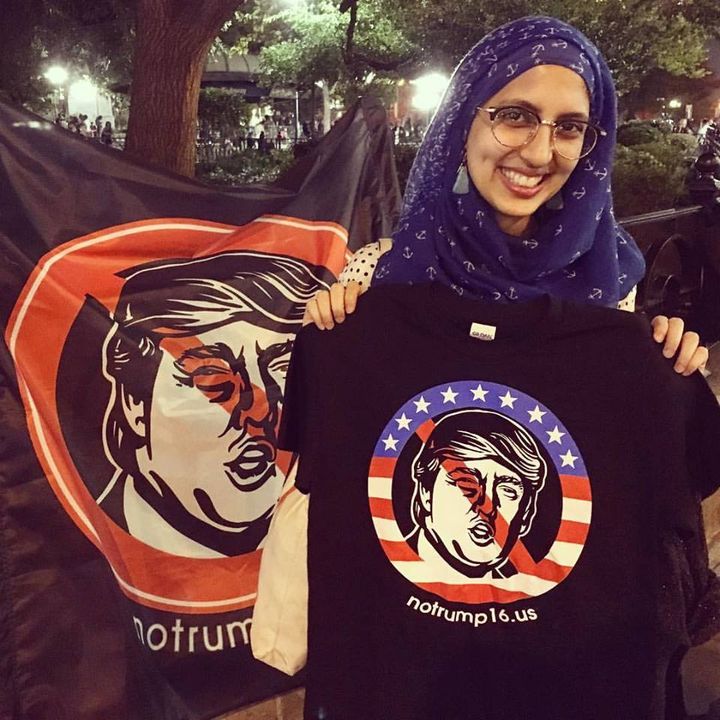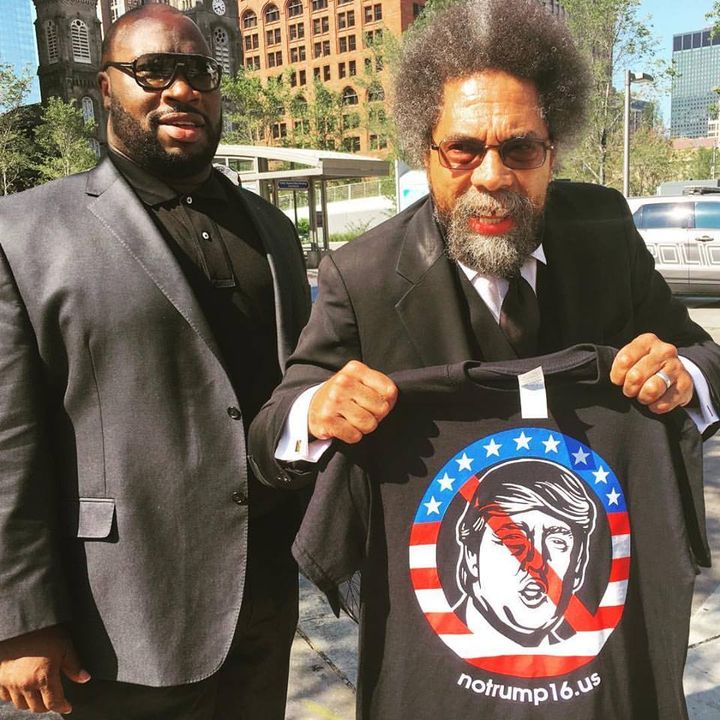
At Union Square in Lower Manhattan, a family wears original, flag, and pride versions of the NoTrump16 shirt.
Six-month political marketing venture documented voter sociology during election
We entered the belly of the beast at the Cleveland politi-con. Under the vigilant gaze of 5,000 seriously-armed police and three times as many media types, our gear was the only prominent display of anti-Trump merchandise for the duration of the Republican National Convention.
“Make America great again by getting this T-shirt,” I would exclaim. Gary Johnson, Cornel West, and Vermin Supreme were among those who heeded our call in the Democratic-leaning Midwestern city, each pausing for a photo opp with our iconic image.
Donald Trump supporters -- as well as his GOP detractors -- would chuckle, especially when told of the “Republican discount” for our classic black-and-white design illustrating the candidate’s trademark coiffed hair, squinty eyes, and pursed lips, stamped with a red “no” sign.
Even the militiamen with heavy-duty weaponry over their shoulders and American flags sewn into camouflage backpacks were surprisingly civil.
At the DNC in the City of Brotherly Love, we battled city licensing inspectors determined to shake down guerrilla vendors of political goods. But we stayed one step ahead of the Philadelphia permit enforcers -- like dealers hawking their product just beyond the long arm of the law.
We sold 3,500 NoTrump16 shirts in just over six months, mostly in New York City, where political items are considered free speech protected by the First Amendment. From hipsters and college kids to African-American grandfathers and Latino families, we captured the political moment.
Taking a respite from corporate journalism — which has largely struggled to contend with the Trump phenom — the project provided experiential and candid exposure to the country’s election psychology.

Screenshot of CNN video that aired August 3 showing NoTrump16 T-shirts worn by Columbus Circle hustlers.
NY state of mind
This election was exceedingly odd, not the least because both major-party candidates were New York City-based blonds. We spent a lot of time at both campaign headquarters. At Trump Tower, a group of paid Chinese-American pro-Trump protesters extolling the virtues of legal immigration, as well as law and order, tried to shoo us away, as police officers stepped in to protect our rights.
In downtown Brooklyn, Hillary’s campaign folk seemed scared to buy shirts more appealing than her official apparel. Also in front of the Democratic frontrunner’s office, Green Party candidate Jill Stein’s pre-debate protesters kept telling us Clinton was no better than Trump.
Along the way, our media appearances included a Reuters video on the liberal gun-carrying activists who created a circus next to us in Cleveland, in addition to an NPR feature juxtaposing politics and profit. The New York Times included us in their top convention T-shirts list. Then in Philly, the Inquirer explained our mission cynically, and Saturday Night Live actors facetiously tried to sell us “Trump Ice” in triple-digit temperatures. Back in New York, CNN profiled some clever hustlers reselling our tees. The New York Post and TheBlaze also captured the zeitgeist at our Union Square base, with all its spectacular counterculture.
I first came up with the T-shirt idea in the spring. The iterations of our shirt that resonated best over the summer were the ”patriotic” red-white-and-blue version and the rainbow LGBT look. Then at Burning Man, the annual self-reliance festival in Nevada, tie-dyed shirts with our emblem reached eager fans. From North Carolina and Georgia to Texas and Myanmar, anti-Trump partisans found an expression of solidarity into the fall.
Some of the most meaningful but challenging interactions were with deaf New Yorkers eager to condemn a future president who’d mocked the disabled. Dutch, Danes, Brazilians, and Italians were among our most frequent customers. Our linguistic range came in handy, with people from all over the globe interested in bringing home a $10 souvenir from such a turbulent and surreal U.S. election.

A young couple from Israel stand in front of Trump Tower, the president-elect’s home, office, and campaign HQ.
‘Our next president’
We faced daily heckling on the mean streets of New York, from April to November, with frequent reminders in characteristically thick outer-borough accents -- often from Staten Island or South Brooklyn -- that we should have crossed out Hillary’s face instead of Donald’s.
“If you design one, maybe we’ll sell it!” we’d respond. “Misinformation,” one angry Trump backer barked, repeatedly, for 10 minutes. “Don't believe the liberal media. These are all lies.” But a quickly reassuring chorus of, “I like that shirt,” “Damn right,” and “That’s what I’m talkin’ about” followed just after, summarizing the favorable opinion of most New Yorkers passing by.
Occasionally we would hear, “Go back to where you came from,” falsely implying we were not American. Or, slightly more polite: “Trump is our next president, so get used to him.” We were also graced by the presence of a naked Trump statue at Union Square, and then even a naked Hillary.
We encountered a gay “Malcolm X supporter” who foisted a sign declaring “white liberals” to be the worst enemy of the black man and of America. But ironically the message found him a soul mate for the evening from the demonized group who appreciated the love-hate. Did we need any further evidence of the young black male frustration that frequently failed to find solace in Hillary Clinton’s words?
We witnessed the mental confusion of an oxycontin-addicted youth who had flunked out of college and yelled for people not to vote Trump, but every third time got the names crossed, and inadvertently said “Fuck Hillary, Vote Trump.” Was this indicative of a millennial population convinced both candidates were bad?
Some curious bystanders appreciated the NoTrump16 concept, but expressed reluctance to be categorized as donning something “against,” not “for” a cause. Others said they didn’t want to wear their views on their sleeve, keeping sensitive topics like politics and religion for private discussions.
The most common reason that liberal people cited for not buying the shirt: “I don’t even want to wear his face on my body.” I’d reply that it was better to sport the anti-Trump brand for the next four weeks than have him in the White House for the next four years. But they’d often claim a “positive” statement would be preferable -- knowing full well that the Democratic candidate was running up a huge enthusiasm deficit with political hats, yard signs, and rally attendance.
On Election Day, a well-heeled Mexican family from Durango wasn’t that interested in spending $20 on the last anti-Trump tote bag for sale. Maybe they knew the end was nigh, and they'd better save their money for when the new president makes them pay for a border barrier. But then at the last minute, the pearl-wearing mother bought a medium white tee.
Perhaps we simply helped Americans, and tourists, become acclimated to the semi-permanent feeling of opposition to Trump, a reality they were ultimately forced to accept on November 8.

Despite widespread antipathy to Donald Trump, and a popular vote win by Hillary Clinton, the Republican winner will soon take office. Many groups, especially racial and religious minorities, are worried about the future.
No Trump, Not Trump, Stop Trump, Drop Trump
While in-between jobs, I decided to be a political entrepreneur and launch NoTrump16. Part startup business, part social activism, the street campaign in many ways chronicled the American left’s futile fight to contain the rise of Donald Trump. Buttons, stickers, and condoms were among the accessories that carried the same logo.
While of course we wanted people to purchase T-shirts, the end result was an experiment with democracy and a microcosm of the larger anti-Trump movement’s finite capacity to mount a viable challenge to the billionaire TV star.
We took America’s political pulse during the election season, submitting an ideological litmus test to key sociological groups in Ohio and Pennsylvania (the states where our garments were screen-printed) and beyond.
Our discussions with tens of thousands of regular folks also confirmed that negative feeling towards Trump was not enough to generate a successful electoral result for Clinton. From the UPS and FedEx delivery men to Maggie, Eddie, Elijah, Tyreek, and Anna-Marie, Americans found in our T-shirts both a reason to hope and a cause for cyclical despair.

The 2004 magazine cover satirically depicting liberal donor George Soros with a Disarm Bush T-shirt.
From Disarm Bush to NoTrump16
In 2004, I was among the founders of Disarm Bush, the seminal effort that graphically and logistically inspired the NoTrump16 project.
Back then, we sold over five times as many T-shirts. Twelve years ago, around 500,000 people marched on the RNC in New York. We didn’t witness anything one one-hundredth that size this year -- until after the votes were counted.
There is no comparison between ill will towards someone already in power, like George W. Bush, perceived as a clear-and-present threat, and fear of a man with a 25-percent chance of getting into office. For much of 2016, Donald Trump was considered a joke, and young urban Americans were passionate about being pro-Bernie Sanders more than anything else.
The NoTrump16 experiment in social media branding incorporated elements of civics, sales, fashion, and journalism too. Our nuanced approach to peddling politics was born out of a sense of balance. It is in this context that we created a tangible manifestation of a powerful and photogenic anti-Trump symbol.
In an age when many digital media companies are hard-pressed to maintain funding — and cope with Trump — this deep dive into election issues seemed like a great opportunity.
Yet there was always fear of revenge under the new administration, in the event that Trump were elected…
And, in fact, Trump won. But we did everything we could to put the most compelling anti-Trump image out there.
Press vs. politics
Our effort was an exercise in the democratic process, which produced a fair if widely discouraging result. Trump’s defeat would have created a nice memento out of our NoTrump16 T-shirt. But his victory made it relevant for the entirety of his term(s) in the Oval Office.
Although there is no rule that says journalists can’t engage politically when they’re not employed by a company, there is indeed a Chinese wall between partisanship and objectivity that governs media ethics.
Staff at the New York Times, for example, cannot give money to campaigns or lend support to a political candidate. “Journalists have no place on the playing fields of politics,” says the company handbook. “Staff members are entitled to vote, but they must do nothing that might raise questions about their professional neutrality.”
However, we never formally endorsed a candidate while promoting anti-Trump principles. Our independent approach emphasized the value of multiculturalism, existentially threatened by an onslaught of bigotry and racism into the mainstream.
“If you’re a working journalist and you believe that Donald J. Trump is a demagogue playing to the nation’s worst racist and nationalistic tendencies, that he cozies up to anti-American dictators and that he would be dangerous with control of the United States nuclear codes, how the heck are you supposed to cover him?” the New York Times’ Jim Rutenberg asked in August.
“Closer than you’ve ever been to being oppositional,” he answers. “That’s uncomfortable and uncharted territory for every mainstream, non-opinion journalist.”
“But the question that everyone is grappling with is: Do normal standards apply?”

Professor Cornel West displays his identification with the anti-Trump movement in downtown Cleveland, OH.
‘Subverting our political life’
Most big news organizations issued critical editorials on Trump, and outspoken journalists like Vox’s Ezra Klein published harsh denunciations.
Political writer Neal Gabler recently questioned whether journalists should ever seek to “normalize the surreal circus [Trump] provides...subverting our political life.”
There is widespread recognition that liberal media became a part of the anti-Trump political machine, and after its failure, there is still resistance to “normalization” of his presidency. Trump employed nasty tactics, although it may have been a populist ruse to get elected.
Either way, the Midtown Mogul will be occupying the White House come January. He won, and it’s time to move on. We can all stop playing the blame game.
Now that the election is over, I’ll be returning to the media business as a news professional faced with the shifting norms of an industry in flux.
Let’s hold leaders to account, demand robust policy ideas, and fight pervasive intolerance. In an era when Steve Bannon’s Breitbart is "state media," our job in an intensely ideological landscape has never been more difficult, or important.
I’ve put my journalist hat back on to deal intellectually with the new situation -- rather than continuing to lug around a big blue duffel full of NoTrump tees.
